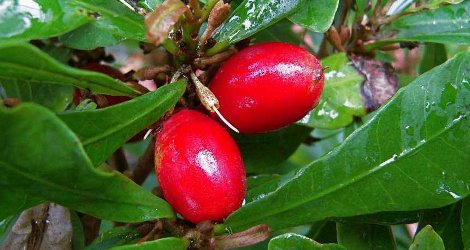Accession Data:
Synsepalum dulcificum (Schumach. & Thonn.) Daniell
- Common Name: Miracle Fruit
- Family: Sapotaceae Juss.
- Description:
Growth Habit: Miracle fruit is an evergreen bush or tree growing to 18 ft. in its native habitat, but rarely to 5 ft. otherwise.
Foliage: The plant has deep green, elongated leaves which grow in a spire-like habit. Both regular and large-leaf and a hairy-leaf form are known.
Flowers: The small 1/4 inch white flowers of miracle fruit are produced in flushes through many months of the year.
Fruit: The fruit is a small bright red, ellipsoid berry approximately 2 to 3 cm long and containing a single seed. Although not sweet itself, when a single fruit is eaten and the fleshy pulp allowed to coat the taste buds of the tongue and inside of the mouth, an extraordinary effect occurs. The fruit will now allow one to eat a slice of lemon or lime without wincing. The marvelous aroma and inherent sweetness of the citrus remains but the sourness is almost completely covered. The effect remains for some 30 minutes or more.
- Culture:
Soils: An acid soil is a must for miracle fruit. They prefer a soil acidity of pH 4.5 to 5.8. This can be achieved by planting in equal parts Canadian acid peat and pine bark. Also peat and perlite mixes are said to give excellent result. In the basic soils of California, the plants slowly die back until virtually only the stems remain. Allow the roots of the plant to fill the container before transplanting into a larger one.
Irrigation: Be sure that the soil is well draining as the plants do not like to sit in wet soils. Coming from a tropical climate they need highly humid conditions. When indoors, especially during the winter months, a small clear plastic bag put around the plant and supported by wood or a wire frame is helpful in maintaining humidity. Also, placing the plant container on a tray with stones on the bottom and filled with water to the top of the stones will add humidity to the local area. Misting the leaves with good water also helps.
Fertilization: Use a water soluble fertilizer such as Miracid and follow the label directions. Use sparingly with frequency dependent on the growing season, fertilizing more frequently during the summer months
Pruning: In general, there is no need to prune the miracle fruit plant.
Propagation: Propagation of miracle fruit is usually either by seed or cuttings. As the seed viability is short, plant the cleaned seed immediately just below the soil line When shipping cleaned seed for others to plant, package in a small plastic bag and enclose a slightly moistened toweling. Seed that are allowed to dry can be shipped for at least two weeks but rapidly loose their viability.
Pests and diseases: Watch for mealybugs, spider mites and other indoor potted plant pests. Waterlogged plant will succumb to root rot.
- USDA Zone: 10b-11
Accession Data:
- Accession # 199900066
- Source: John Maugeri
- Recorded Vouchers:
- Voucher 217613 at George Safford Torrey Herbarium (CONN). Specimen collected 6 July 2010. Herbarium Image
- Accession Date: 06-13-1999
- Bench: 1111 - AFR:Ground Bed 1 SE
- Currently: active - healthy
- Qty: 3 confirmed on 07-01-2025
Classification:
- Division: Magnoliophyta
- Class: Magnoliopsida
- SubClass: asterids
- Order: Ericales
- SubOrder:
- Family: Sapotaceae
- SubFamily: Chrysophylloideae
- Tribe:
- SubTribe:
Flowering Data:
This accession has been observed in bloom on:| Year | Jan | Feb | Mar | Apr | May | Jun | Jul | Aug | Sep | Oct | Nov | Dec | ||||||||||||||||||||||||||||||||||||||||
|---|---|---|---|---|---|---|---|---|---|---|---|---|---|---|---|---|---|---|---|---|---|---|---|---|---|---|---|---|---|---|---|---|---|---|---|---|---|---|---|---|---|---|---|---|---|---|---|---|---|---|---|---|
| 2025 | ||||||||||||||||||||||||||||||||||||||||||||||||||||
| 2024 | ||||||||||||||||||||||||||||||||||||||||||||||||||||
| 2023 | ||||||||||||||||||||||||||||||||||||||||||||||||||||
| 2022 | ||||||||||||||||||||||||||||||||||||||||||||||||||||
| 2021 | ||||||||||||||||||||||||||||||||||||||||||||||||||||
| 2020 | ||||||||||||||||||||||||||||||||||||||||||||||||||||
| 2019 | ||||||||||||||||||||||||||||||||||||||||||||||||||||
| 2018 | ||||||||||||||||||||||||||||||||||||||||||||||||||||
| 2017 | ||||||||||||||||||||||||||||||||||||||||||||||||||||
| 2016 | ||||||||||||||||||||||||||||||||||||||||||||||||||||
| 2015 | ||||||||||||||||||||||||||||||||||||||||||||||||||||
| 2014 | ||||||||||||||||||||||||||||||||||||||||||||||||||||
| 2013 | ||||||||||||||||||||||||||||||||||||||||||||||||||||
| 2012 | ||||||||||||||||||||||||||||||||||||||||||||||||||||
| 2011 | ||||||||||||||||||||||||||||||||||||||||||||||||||||
| 2010 | ||||||||||||||||||||||||||||||||||||||||||||||||||||
| 2009 | ||||||||||||||||||||||||||||||||||||||||||||||||||||
References (internal):
- EEB Greenhouse Holdings native to: Benin / Ghana / Ivory Coast / Nigeria / Central African Republic / Cameroon / Congo / Gabon / Zaire
References (external):
- How a small red fruit performs taste miracles @ NPR
- Human sweet taste receptor mediates acid-induced sweetness of miraculin @ PNAS
- California Rare Fuit Growers Fruit Facts Online
- The Plant List (2010). Version 1. Published on the Internet; http://www.theplantlist.org/ (accessed 4 November 2013).
- Synsepalum dulcificum. (2011, June 18) at Wikispecies. Last accessed 4 November 2013
- WCSP (2013). World Checklist of Selected Plant Families. Facilitated by the Royal Botanic Gardens, Kew. Last accessed 4 November 2013.
- The Global Biodiversity Information Facility: GBIF Backbone Taxonomy, 2013-07-01. Accessed on 2013-11-04
data regenerated on Tue, 01 Jul 2025 11:24:40 -0400 [bcm v4.0]
Images:

Additional images for this accession:
Click on thumbnails to enlargeCurrent Accessions in the Sapotaceae
Subfamily Chrysophylloideae
Subfamily Sapotoideae
Tribe Sapoteae
W/C = Wild Collected
 = indicates flowering in past 14 days
= indicates flowering in past 14 days
 = images available for this accession
= images available for this accession
 = map available for this accession
= map available for this accession
 = accession added within past 90 days
= accession added within past 90 days



